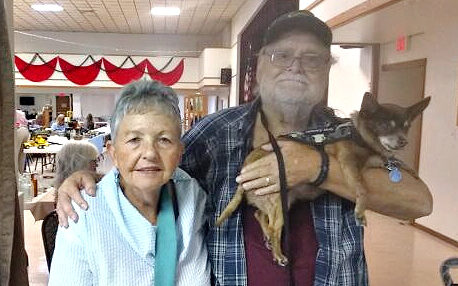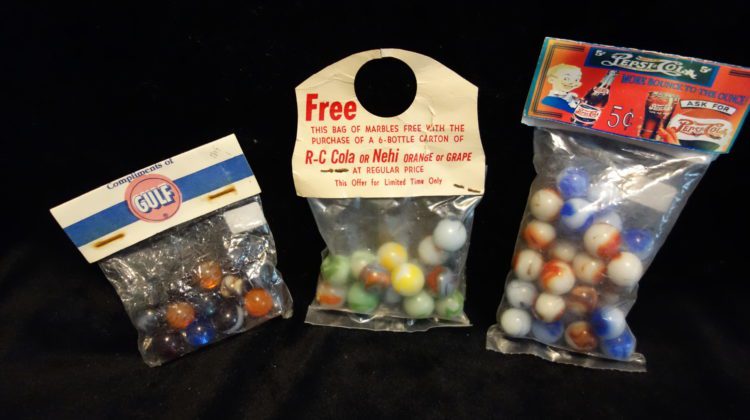
“Decision making, like coffee, needs a cooling process.” George Washington[1]
A $3.00 Bill & Marble Packaging
It isn’t illegal to print $3.00 bills. The United States government has never issued one so it can’t be counterfeit. Likewise it isn’t illegal to print headers that look “defeated” —shop worn and old. There is no law regarding stapling these headers to cloudy poly bags—and then putting new Asian marbles inside the bags.
With modern printers, it is easier than ever to make and distribute poly bags “advertising” anything you want. “New old” headers can have more colors and sharper images than was possible in the 1930s – 1950s. You can run a batch of “old headers” on modern printers.
Soak some staples in water. Put a few sparkly marbles in a poly bag, use a “scratch pad” on the outside of the bag, staple the header to the bag with rusty staples and voila! You have some very interesting “antique” marbles for sale. Sellers, dealers, and shop owners don’t need to say a word about the bags. Let them speak for themselves…even if they are telling lies.
In Chapter Two “Atlanta Marbles: Fake, Fantasy, or Legend” in our book The Secret Life of Marbles, we present a comprehensive analysis of fake and fantasy marble packaging and, in that chapter, we explore the principals of ethical values and sense of fairness involved in the sell and distribution of bags and marbles made to look old and made to deceive. We stand by what we wrote in our book, and we are not going to plow that ground again.
In this post we just want to lay out a few of the odd, unusual, weird, and puzzling marble bags and marbles which we have found over the years. We have learned that it can be fun to add a few of these strange ones to your collections.
Nationwide 20 Winners
Around Christmas 2021 we visited the Yellow Door Antiques and Art in Rome, Georgia. Larry bought what we are convinced is a fantasy bag of marbles for $5.00. We first saw this bag in the shop when we lived in Rome about two years ago, so we know that it was for sale for at least two years!
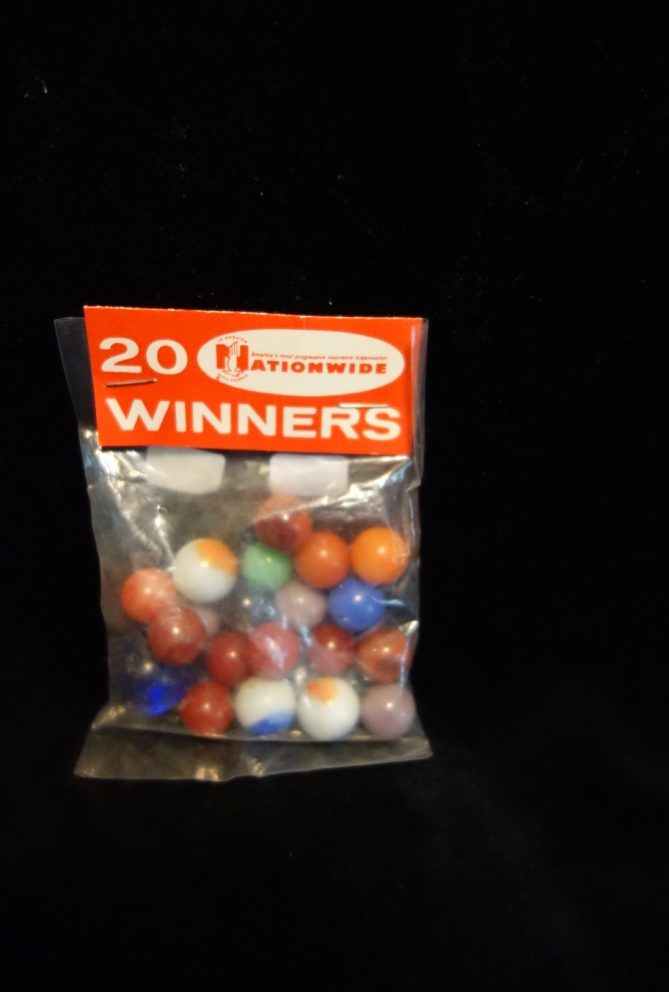
We have seen this package advertised online as “new old stock” and “vintage.” We saw new old stock bags of marbles on the shelves in the R.C. Marshall Hardware store in Cairo, West Virginia. The mercantile store opened in the early 1900s. So we know that new old stock bags of marble do exist.
But probably not in this case. As you can see this is a poly bag and there is no visible seam, which should be down the middle of the back of the bag if it was genuine. The staples are new. The marbles are a mixed bag of players, a blue clearie “shooter”, and a couple of patches.
The header is the “right color” for Nationwide insurance and in tiny letters it reads “In Service with People”® and, a bit larger, “America’s most progressive Insurance Organization.” A second online site dates them to the late 1960s and values them at $7.99.
Nationwide is a very real Fortune 100 company. It has been in business since 1926.and was originally sponsored by Farm Bureaus. Farm Bureau Mutual later changed its name to Nationwide in 1955.
To date, we have been unable to make contact with the company to learn whether or not they have any evidence that these marbles really were used as advertising in the 1960s.
This little bag has puzzled us for years. If it is a fantasy, as we suspect, why would anyone go to such trouble to ensure the correct slogan “In Service with People”® which was in use in the 1960s? The slogan “Nationwide is on your side” was adopted in 1973. And why use the correct logo? We don’t know, but if you do have information about this bag of marbles then please send us a Comment and we will add a welcome update to this story.
Sex-Lax
In June 2019 while antiquing in Otto, North Carolina, we found a number of fantasy bags of marbles. We own most of the ones we saw and we have seen many of the rest. The dealer had grouped a number of these bags together. We did find a poly bag of 20 glass marbles unlike any we have ever seen!
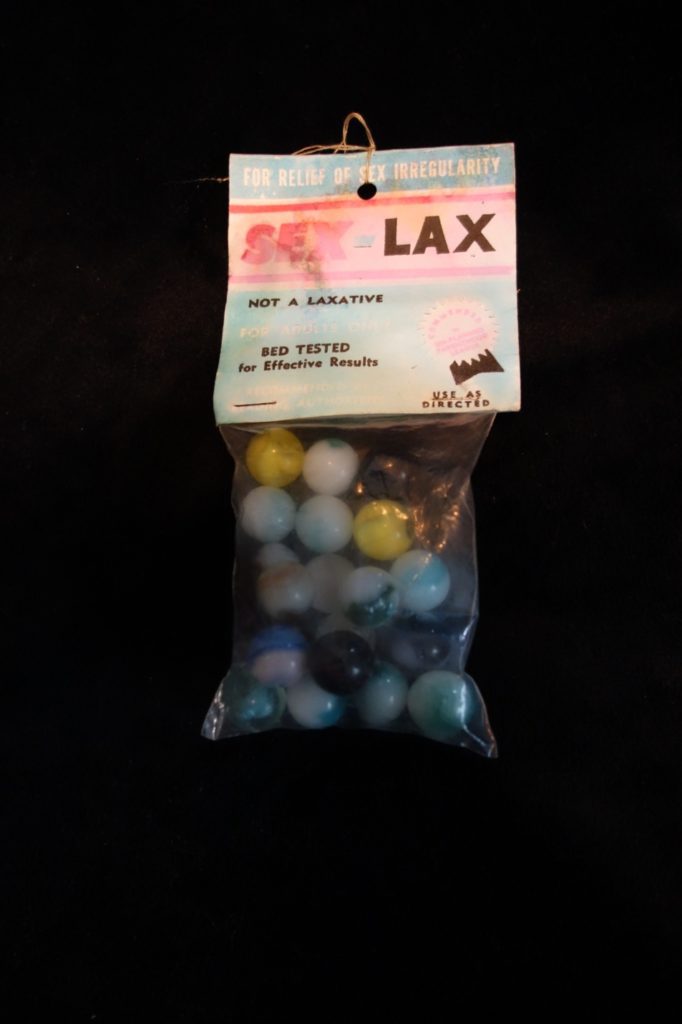
The marbles include two bright yellow Marble King Cat’s Eyes which are UV reactive. There are also a couple of black game pieces and what some nice patches.
The header is 3¼” long X 3¼” wide. It appears to have been purposely aged by wetting. If not purposely aged then we really don’t want to know what happened to it! At any rate, the header is blurred and faded as you can see in the photograph. The writing on the header card advertises “For Relief of Sex Irregularity Sex-Lax”. The header continues “Not a Laxative [thank goodness!] For Adults Only Bed Tested for Effective Results”.
What a Puzzle!
There is more information on the front and back of the header. The information on the back of the card stopped us short. There is a section for ingredients which reads “Made of gum base, sugar, corn syrup, softeners, natural and artificial flavors, certified food colors.” Very confusing.
This made us think of the 1935 boxes of 120 chocolate-covered marbles from the Brock Candy Company in Chattanooga, Tennessee. We know that chocolate covered marbles are hard to imagine, but reference Plate 341 in Everett Grist’s Big Book of Marbles on page 157. We bet they tasted good!
The Sex-Lax bag is ©1968 by The Leister Game Co., Inc., Toledo, Ohio. The Leister Game Company was (or is) very real and it was in business in 1968 at 511 Sumner Street in Toledo, Ohio. We had no luck finding any Catalog for the Company, and the telephone number listed online is out of service.
Looking for Information
We did find an obituary from the Toledo Blade for Reginald Leister who died in 2016 at age 79[2]. Mr. Leister “…spent his career at the family business, Leister Game Co., which was a successful game company known for joke and novelty items and gifts” [emphasis added] according to the Blade. We believe that the enterprise was started in 1932.
Leister products included booklets, games, card games, and novelties for bridal showers, “stork showers,” and bachelor parties [again, emphasis added]. We suspect that this package was a joke gift at a “Bachelorette“ or “Bachelor” party.
Did Leister ever produce candy which was packaged with these same headers? While it appears that they did, we cannot provide any evidence of that. Certainly, they never marketed marbles. However, the header has the “flavor” of a 1960s “joke”: the candy came in three sizes “normal, abnormal, and sex maniac.” His Obituary notes that Mr. Leister often said “This Joke is a Job.” Today the very idea of such a novelty item seems both unsophisticated and unrefined and it is possible that Leister never sold it.
Did Leister market it and then pull the candy? Were the headers left over stock? And finally is the bag of marbles a fantasy or a fake? Or is it a fake/fantasy? This is a very odd one indeed.
What We Found Out
In June 2019, and after sending an email, Larry spoke with staff at the Toledo History Museum. They confirmed what we knew about the Leister Game Company and gave us some leads. It is apparent, however, that the only real way to know if the Company ever made Sex-Lax candy is to ask a family member. We certainly do not plan to intrude on the family.
The staff member did send a link to us. It is for a 2003 Toledo Blade article[3]. In the article Reginald Leister said this about his “seat of the pants” R&D: “’I watch the news a lot to see what’s going on…. I look at signs and go to shops.”
Based on other things reported by Homer Brickey it is apparent that that Mr. Leister was good-natured and friendly. He enjoyed being with his family and friends. His Obituary notes that “he will be remembered for his sense of humor and passion to create laughter, spontaneity, [and] adventure….” He was also a philanthropist.
In 2003 Leister Company was 62 years old. One of their retail outlets at that time was Spencer’s.[4] Spencer’s Gifts was started in 1947 and today they have over 600, mostly mall based, stores.
We have never seen another bag of Sex-Lax marbles and we expect we never will. The bag is a window into the past. In 1968 it was fun, edgy, and popular. Even good natured.
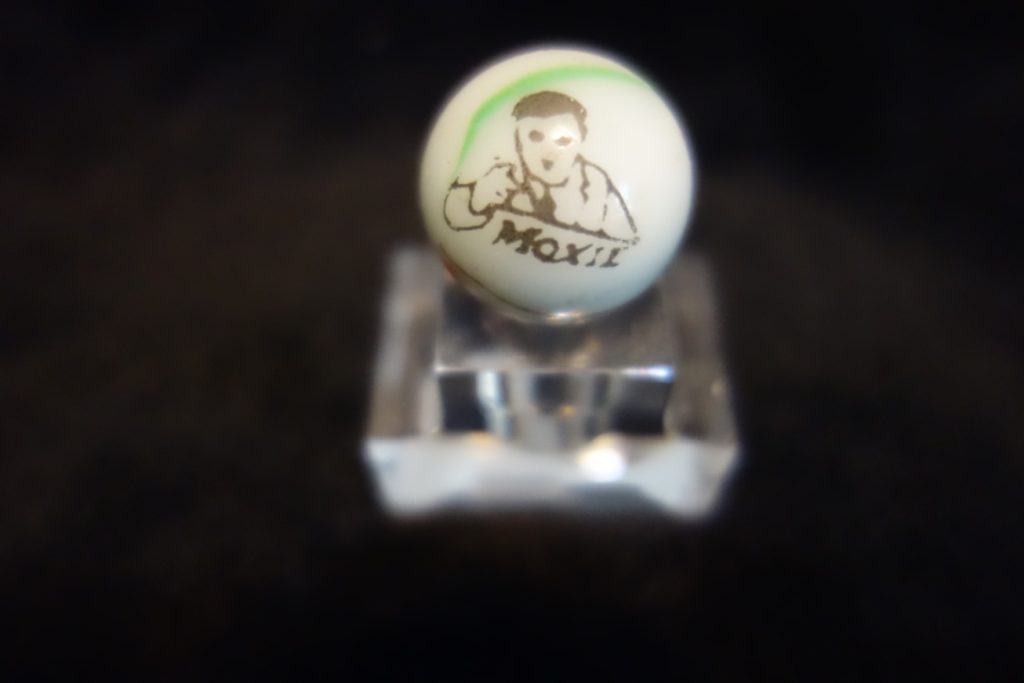
Moxie
In mid-September 2019 we visited Avonlea Antiques & Interiors in Jacksonville, Florida. This is a wonderful shop and we could stay all day!
They even have a bar and café, with appropriate libations, just in case their customers need a pick-me-up before starting off anew. We bought a sulfide marble, a 1939 New York Art Fisher Jewel Tray made by Vitro Agate Company, a marble bag, a genuine 1940 National Marbles Tournament medal, and so much more.
Science tells us that we start to gain a sense of humor as early as six weeks old and that we start to lose it beginning about 23 years old. Men and women view humor differently. And, of course, humor—what is a joke and funny—changes over time and across cultures. While we wouldn’t buy another bag if we ever found one, we are happy that we have this tiny window into the past.
Just For Fun
The collector[5] we bought all our marbles and marble-related goodies from is also a seller. He seems to be a lot like us. Evidently, he simply collects what he enjoys. Some marbles and marble-related items are old; others are reproductions or even fakes. He labels everything in his collection carefully and sales appropriately. You absolutely know without question what you are getting before you buy.
Joanne bought this 15/16” Moxie marble with what appears to be an older company imprint of a man or boy on the marble along with the word “Moxie”. The image reminds us of the May 2, 1925 cover of Collier’s: The National Weekly which we have in our collection.
The marble has a white base and green, purple, and flame red patches or ribbons. It may be a tri-color patch. You can see the green color in the photograph. Our first impression of the logo, which is a screen print, is that the boy is shooting marbles. The marble came on a nice acrylic stand.
Was Moxie Real?
Of course, there is a drink called Moxie and its origins date to the late 19th century in New England. We have read that it is an acquired taste. If you want to learn more about Moxie then read the article “Moxie Bitters — So What is Moxie?”[6]
We learned online that the marble is likely a fake: Moxie never advertised this way. In fact, there is some disdain expressed online about this type fake. We would call it an advertising fake. Some collectors call them genuine advertising marble specialties. We do own a couple of marbles of marbles which were used over the years as business cards. One is an antique and we met a gentleman in Tennessee who always has advertised his business with shooter-size glass marbles.
We wrote to a couple of New England historical societies to see if they could tell us anything more definitive about the Moxie marble, but we have not received a reply yet. Frankly, like the dealer we bought from, we do not care if it is “real” or not. We had never seen the marble before, and we have never seen one since. We really like it!
A Couple More Thoughts on Character Marbles
Most collectors are aware of the Peltier Glass Company Comic Character Marbles. If not, you might want to check Six, et.al. American Machine-Made Marbles, page 133. The authors reference George W. Angerstein’s application to the US Patent Office.
Angerstein developed a way to apply selected newspaper comic characters to marbles and then coat the image with a very thin layer of clear glass so that it could not wipe off. Some collectors use a knife blade to try and scratch off the color of any “decal” on a marble to test the quality of the image. The twelve comic marbles made in the 1930s by Angerstein are still as crisp and clear today as when they were produced by Peltier.
Angerstein’s Patent (1,972,854) was issued in 1934. His application title reads: “Method of application of indicia to rounded surfaces of small radius.” In fact, the radius was between 19/32” and 11/16”. Indicia? We have never heard the comic marbles called “indicia marbles.” Also note that in his patent figures and sketches Angerstein never mentions marbles.[7]
But it Ain’t Real! Or is it? Hang Tag Poly Bags
Our lead photograph shows a poly bag of bottle hanger marbles. This was a special type advertising which was popular in the late 1930s – 1950s. The header was designed to fit over the neck of a soft drink bottle and the customer got one bag with each six-bottle carton of sodas purchased. The bottles were glass and the cartons were made of stiff cardboard with a carry handle.
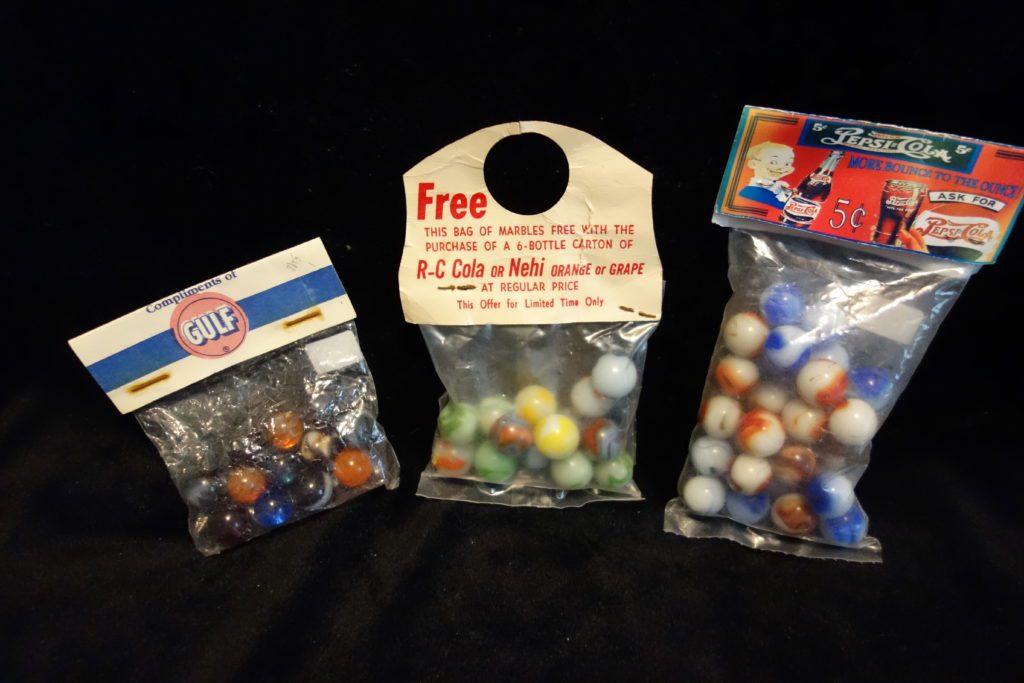
We bought this bag of 14 Alley Agate marbles in early May 2019 at Liz’s Antique Mall, Cartersville, Georgia. It advertises R-C Cola or Nehi Orange or Nehi Grape “at regular price” and for a limited time only. This same advertising bag and hanger was used on three type products. The back of the header card is blank. This makes sense since the back was never meant to be seen by the customer.
R-C Cola or Nehi Orange or Grape Hang Tag
We studied this hang tag poly bag for days and returned to Alan Basinet’s[8] outstanding research which he published online in “Fakes & Reproductions”. Like most collectors we have used MarbleAlan’s website for years to learn and to identify marbles.
We selected the main points which Basinet made about fake or reproduction marble bags and then we carefully compared each salient point against the R-C Cola hanger. Here are some of those comparisons:
- “Polyvinyl packaging started around the late 1940s…. This latter type, usually simply called ‘poly bags’”. Our marbles are in a poly bag and we are confident that the marbles do date to the late 1940s – early 1950s.
- “Several companies not only distributed these bags under their own brand names, but also sold them to corporations that used the marble packaging as promotional giveaways. This became especially popular throughout the 1950s…. Old marbles are never placed inside fake bags; the marbles are always new.” We are positive that the marbles in the bag are old.
- “…rusty staples should not be construed as an indicator of age, particularly when there is an accompanying staining of the paper surrounding the staple.” We talk about rusty staples in the opening paragraphs of this story. Our staples are rusty and blunt, but staining doesn’t “spread out” around either staple. You can see this in the photograph at the top of this story. For some reason, our staples are from back to front on the header.
- “One trait possessed by all early polyvinyl marble packaging is that there will be a wide seam down the back of the package. This is not found on reproductions.” Check; wide back seam.
- “The packaging on older bags is also thicker and is heat sealed along the bottom, leaving a seam that measures around 1/4″. Bottom seams on the new bags is much more narrow.” Check, check, and check.
- “Authentic older polyvinyl bags are often cloudy sometimes making it difficult to clearly see the marbles. New bags are generally clear and very transparent.” Cloudy: check.
- “Genuinely old polyvinyl bags almost always show some type of wear such as ragged edges or soiling.” Our old header/hanger is wrinkled, and it has one crease tear. You can see this wear in the photograph.
- “…The headers on fake poly bags are often printed with an inkjet printer, which leaves telltale dots (which are easily observed under magnification) on the print rather than the continuous inking of older styles of printing.” We checked our printing with a Carton 10X loupe. The old print was not applied with an inkjet printer since there are no “DOTS” in the red print.
Once we were convinced that the packaging is old, we wanted to learn something about how old. The hangtag is for R-C Cola or Nehi Orange or Grape. But when did R-C Cola bottle both Orange and Grape Nehi?
The Nehi line of fruit flavors (orange, grape, etc.) was introduced in 1924, and the line became so successful that in 1928 the company changed its name from Chero-Cola Co. to the Nehi Corporation.[9] So, Nehi came before R-C Cola which was not introduced until 1934.
In 1944, the courts ruled that Coca-Cola did not, own the word “cola,” thus allowing Royal Crown to become Royal Crown Cola, or RC Cola. With nationwide distribution and sales on the rise, Nehi invested heavily in advertising and slowly and steadily, RC found its way into Drug Store soda fountains and onto grocery store shelves Nation wide.
So, the dates of late 1940s and early 1950s are solid. Nehi was investing money into advertising, the product was being placed into more and more grocery stores, and Nehi was using any type innovative marketing strategy they could.
Wait a Minute……
Still, even while we were in the shop we wondered about the Alley Agate marbles which are in the bag. We did not think that Alley Agate ever packaged bottle hang tags.
Further research in Dean Six, et.al., tells us that “early Marble King poly bags are found to hold Alley swirls or mixed Peltier marbles in counts of fourteen, nineteen, twenty, or forty.” The marble count for our pack is fourteen.
Dean Six, et.al. explain that Marble King had a special packing room which ran two-men shifts twenty-four hours a day just to package Soda bottle marbles “…when the six packs came out and they were really popular and the bottle hangers were made just for these packs.[10]”
To conclude, the hanger is authentic, it dates to the late 1940s – 1950s, it contains 14 opaque Alley Agate swirls, and it was packaged by Marble King, Inc.
Last Thoughts: As Real as a $3.00 bill?
Fake, fantasy, and reproduction marble bags, nets, and single marbles found “in the wild” can present real principled dilemmas for collectors. We understand this. Individuals new to the hobby can be deceived into paying too much for what they believe to be genuine old marbles. We accept these facts and we would never even attempt to justify any means or methods of deceit. We still find cheap “fake marbles” at flea markets and estate sales and sometimes in an antique shop. We do not tend to buy any of these off the Internet.
When you can buy a mesh, poly bag, or shooter for $5.00 or $10.00, and you cannot be certain whether the marbles are genuine or not, it can prove to be a real challenge and learning experience if you buy it and, like we did with our hang tag poly bag, study it until you are positive whether or not it is “real” or not.
If it is then you have a nice addition for your collection and if it isn’t then you have learned something which you can share with others and you have a nice conversation piece. And the whole process, like with our Sex-Lax bag, can be a lot of fun along the way.
As always when we write about and study “fakes” we return to a singular question: Exactly who among us serious collectors decides that any bag or an individual marble is fake? How do they know and how can they be positive? How do they tell the rest of us so that we don’t get gypped?
We hope that everybody can keep an open mind. Things are not always what they seem: some of the marble bags on the market are as fake as counterfeit than a $3.00 bill! Some fakes are as convincing at the quote from George Washington at the top of this post. Read the first footnote below for the truth.
Footnotes
- Nope! This attribution to Washington is as real as a $3.00 bill! He never said it. In fact, some of the phraseology didn’t even exist in the 18th century. But want to know something that sounds fake but is true about Washington? According to cash receipts, his diaries, journals & papers, Washington visited Christiana Campbell’s tavern in Williamsburg, Virginia, 91 times! Certainly, he reveled the lively political discussions at Christiana’s. But she was also a good cook and she served crab, shrimp, fish, & scallops. If you want to read more about Washington’s times in Williamsburg a good place to start is https://founders.archives.gov/documents/Washington/01-02-02-0003-0013-0005 6/27/2022 ↑
- Reginald Leister Obituary. Published by The Blade, Toledo, Ohio, on 20 September 2016. https://www.legacy.com/is/obituaries/toledoblade/name/reginald-leister-obituary?id=19104595/ 6/29/2022 ↑
- Brickey, Homer. “Innovation, Research No Strangers To Toledo Area Small Companies—Experts say Size Often increases Nimbleness.” Toledo Blade 14 September 2003, Business, page D1. https://www.toledoblade.com/local/2003/09/14/Innovation-research-no-strangers-to-Toledo-area-small-companies/stories/200309140046 6/29/2022 ↑
- We are aware that Spencer’s Spencer Gifts has come under fire for its merchandise, which has been considered to be sexually explicit and racist. Spencer’s was rebranded in 2003. “The company has been investigated by the Federal Trade Commission (FTC) for its advertising practices….” And the Company has been at the center of a number of controversies over the years. If you have ever visited one of their shops you can quickly see why. You can also read about Spencer’s at: https://en.wikipedia.org/wiki/Spencer_Gifts 7/1/2022 ↑
- We have his name in our files. ↑
- https://www.peachridgeglass.com/2013/07/moxie-bitters-so-what-is-moxie/ 7/1/2022 ↑
- As an aside: It is interesting to note that Harold D. Bennett made ½” comic strip marbles. We came across a red Betty Boop in a shop in Alabama and also have one of Bennett’s “Moon” marbles. You can check Bennett’s two “new-comic-type marbles”; Plates 359 and 360 in Everett Grist’s Big Book of Marbles on pages 168 – 169. ↑
Alan died in March 2012. You can read his essay today at: https://buymarbles.com/marblealanhome.html 7/4/2022 ↑
- https://www.beveragesdirect.com/products/nehi-orange-soda 5/5/2019 ↑
- Six, et.al. American Machine-Made Marbles paged 97 – 98. ↑
Comments:
Thank you Larry! Great article. Mary Billingsley, Marble Collector
Thanks, Larry-interesting article. Seems like a lot of hard work for little return. I guess if counterfeiters sold enough of them?
Matt Fenske, Owner, Island Fire Glass www.islandfireglass.com
Dear Larry, Thank you very much. It’s always interesting and refreshing to read your stories. Please keep up the good work! Best regards, Dr. Gerhard Greiner-Bär, Lauscha, Germany
.

